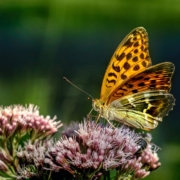The Disappearing Bug
As a child, I liked rescuing bugs from drowning in our farm stock waterers. I’d let them sit on the palm of my hand until their wings dried and they flew away. You can still find me checking my stock waterer for bugs in distress today. Except this year, there’ve been hardly any to rescue. I’ve also noticed a lot less bug splatter on my windshield. Have the bugs gotten smarter or are they just not here? I did some reading and it turns out that I’m not imagining things; insect populations world wide are plummeting at alarming rates.2
Why should we care about disappearing insects? Well, for starters, we all like to eat. We can thank insects for pollinating many of the fruits and grains that grace our table every day including raspberries, blueberries, cherries, grapes, peaches, almonds, beans, clover, carrots, pumpkins, melons, cabbage, citrus fruits, potatoes, almonds, canola and even coffee. Insects, especially bees, wasps, moths, butterflies, flies, and beetles, are the most common pollinators of Earth’s 350,000 + plant species. It is estimated that 87.5% of plants are pollinated by insects and other animal pollinators (bats, birds, lizards, etc).
Where have all the insects gone? Habitat loss, pollution (pesticides, fertilizers, etc.) and introduced species are some of the main contributors to insect loss. Unfortunately, insects that benefit from the growth of human populations include mosquitoes, ticks and other vectors for diseases (vector born diseases have increased over 3 times in only 15 years).3
What can you do to help bugs? If you’re a farmer, you can spare a patch or two of wetlands or shrubs in your fields. If you’re a residential home owner, you can leave those dandelions alone and reduce your use of herbicides. If you have a family, you can teach your kids to value insects as an important part of our food chain. Build a bug hotel, plant a butterfly garden, don’t stomp beetles, learn to love (or at least like) your creepy crawly neighbours.
Our next issue of Eagle Point Nature News is our Bug Issue with ideas for bug related activities you can do with your kids. Subscribe at www.epbrparkscouncil.org/subscribe to get your copy.
1 Francisco Sánchez-Bayo, Kris A.G.Wyckhuys ‘Worldwide Decline of Entomofauna: A Review of Its Drivers,’www.sciencedirect.com, Biological Conservation, Elsevier, 2019, p.8-27.
2 Jeff Ollerton, Rachael Winfree, Sam Tarrant “How many flowering plants are pollinated by animals?’https://onlinelibrary.wiley.com, Oikos, Vol. 120, 2011, p.321-226.
3 https://www.healio.com/news/infectious-disease/20180612/many-health-departments-unprepared-for-sharp-rise-in-vectorborne-diseases.



